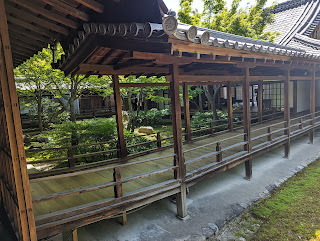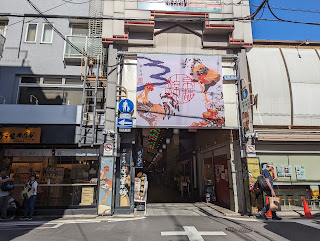Our apartment in Kyoto was located in Gion, the city's most famous entertainment district and the center of traditional arts. For months and months before our trip, we'd read countless advisories about how many tourists had been harassing the geisha walking down the district's lanes and trespassing on private property. What a sad commentary on foreign travelers' habits.
We walked along Shijo, a major street, and, if we'd blinked, we would have missed seeing the tiny little Chugen-ji aka Meyami Jizo Temple from 1022. We wanted to admire its statue of Jizo, a kind of Buddhist guardian saint or bodhisattva. Jizo is a small, monkish-looking figure with a red bib seen in temples and on roadsides throughout Japan. You'll see plenty more Jizo photos in upcoming posts, I promise you!
At this temple, Jizo also doubles as a legendary superhero and faith healer. According to one story, when severe flooding caused the Kamo-gawa River to burst its banks in 1228, many people prayed to Jizo for help because their lives and businesses were in danger. One local official swore he'd seen Jizo physically saving people from the rising waters. Since then, Jizo has become known as Ameyami Jizo or Rain-Stopping Jizo. Later, his statue gained a reputation for miraculously curing people's eye diseases and the name changed again to Meyami or Eye-Curing Jizo.
A couple of blocks from Chugen-ji/Meyami Jizo Temple was Hanami-koji St. or the 'blossom viewing lane' or it would be at least in springtime! The street was Gion's most famous street south of Shijo and was bordered on both sides by traditional teahouses called chaya. On the corner of Hanami-koji and Shijo was a huge red-walled teahouse called Ichiriki Chaya.
Even though we hadn't been in Japan long, it had been enough time to be well aware of the many 'no' signs posted throughout! Here are a couple of them. I obviously chose to ignore the latter sign.
At the end of the street was the entrance to the large Kennin-ji Temple complex that dated from 1202 and was the oldest Zen temple in Kyoto, one of the main branches of Buddhism in Japan. As with many wooden temples in the city, it burned down several times so the current buildings are only 250 years old. The temple was founded by Myōan Eisai, a very influential Buddhist priest, who made two visits to China in the late 12th century. He brought back to Japan two things that are fundamental to Japanese culture, the teachings of Zen Buddhism and tea. He was especially concerned about the importance of tea's health benefits as he thought it would help his monks stay awake during long periods of zazen meditation! Tea ceremony practitioners visit the temple to give thanks for Esai's precious import.
In the Hojo building, we immediately noticed the splendid screen painting depicting the thunder and lightning gods by Tawaraya Sōtatsu. Though it was an impressive and iconic image, it was a replica, and the original was in the Kyoto National Museum.
The rippling stone, square garden was characterized by its central bush and was bordered by the priests' living quarters, the abbot's quarters, and a reception room. The garden's design was based on the famous calligraphic work by Sengai Gibon who believed that all things in the universe are represented by the circle, square, and triangle.
Most hedges at the temple were tea bushes in honor of Esai.
Before entering, we had to remove our shoes and Steven's walking sticks and the bottom of my cane were wiped clean so they wouldn't dirty the tatami mats covering the floors. I shall long remember the sound we made on the squeaky, wooden nightingale floors that truly sounded like birds chirping. Legend has it that the floors were intentionally made to create a noise so residents would know when enemies arrived!
We were extremely lucky to snag the last two pairs of rubber sandals before walking by the rock garden and toward the teahouse. We both thought that life couldn't be any more peaceful than this scene right now. It was blissful and a perfect place to recharge. I'd loved to have known how often the sand design was changed and about the garden's maintenance. The exquisite garden brought back the memory of our son, Alexander, who created a Zen sand garden 17 years ago as part of his Boy Scout Eagle project.
Nearby, a stone monument honored Esai's importation of tea.
We were struck by another of the temple's magnificent sand gardens that was in front of the Hojo. Its placement of large rocks and green moss on white gravel is a style of garden known as kare sansui or dry landscape garden, a feature often found in Zen temples.
In another room were the Clouds and Dragons.
People wrote their wishes on small wooden tablets called ema and then tied them up before the altar.
We thought we'd likely come upon a funeral but couldn't ask anyone. I stood entranced by the solemnity of the occasion even though I was unaware of what was happening.
The shrine's main feature was an unusual power stone with a hole in the center which is said to help people break their bad connections in life and make good ones. To harness the stone's power and make better relationships, believers first pray at the main sanctuary and then write their wishes on specific strips of paper purchased from the shrine. With their wish in their hands and in their head, they then crawl through the stone twice, once in each direction. After completing their symbolic rebirth, they attach the wish to the stone.
Rickshaws were pretty common in the Gion district.
Across the street was Ebisu-jinja Shrine, home to Ebisu, the god of good fortune and prosperity. Though Ebisu is from the Shinto folk religion, it still has close connections with the nearby Buddhist Kennin-ji site we'd just toured. According to legend, Kennin-ji's founder, Eisai, was traveling back from China to Japan when his ship was hit by a terrible storm. Fearing his ship would sink, he prayed to Ebisu, also the guardian deity of seafarers, and the storm quickly passed.
Steven and I had a hoot taking turns throwing coins in the lucky coin toss basket. He was far better at getting coins to land in the basket than I!
I think we both had enough of religion for the day and happily walked along Shimbashi Street, a flagstone lane bordered by traditional buildings and willow trees that follow the Shirakawa Canal.
I spoke too soon as we spent a couple of minutes at the tiny Tatsumi Daimyojin Shrine in the middle of the pedestrian lane. We must have gotten there at the wrong time because we didn't see any neighborhood geisha visiting the shrine.
The rear of the shrine:
On a stone beside the canal was a poem written by the late poet Isamu Yoshi, a great lover of Gion. The stone was located where a teahouse had been over the canal. He wrote the poem so that people who stayed there could hear the water below. Each November 8th, a ceremony is held in Yoshi's honor and geisha lay flowers in front of the stone.
Likewise, no public smoking was allowed or bike riding on the sidewalks.
Nishi Market was a narrow, covered, five-block-long shopping street with a hundred-plus restaurants and shops known as Kyoto's Kitchen.
If trying many varieties of rice crackers is your thing, Nishi Market is your place!
I loved just looking at the beautifully wrapped items even if I didn't know what most were or was brave enough to consume them.
Next post: Getting some 'serious' shopping in at the Nishiki Textiles Museum, visiting a castle, and strolling along the famous Philosopher's Path, plus a couple more temples for good measure!
































































































Why didn’t you do this or at least some of it at night? Love,
ReplyDeleteZachary
A very good question. I guess in hindsight we could have chosen to walk some of the Gion streets at night but we didn't realize when we began that morning it would be so dead.
ReplyDeleteYour posts on Kyoto under brilliant blue skies remind me of my mom's many photos of the area -- oh how she loved her visit there ! xo Lina xo
ReplyDeleteLina, You and Dan should consider following in your mom sister's footsteps and taking your own trip to Japan. I think you would also appreciate its great temples and artistic beauty if not all the rules. Happy 43rd anniversary today to you both! XOXO
ReplyDelete